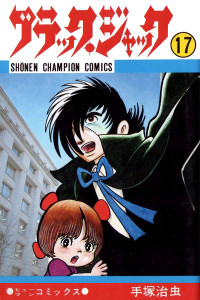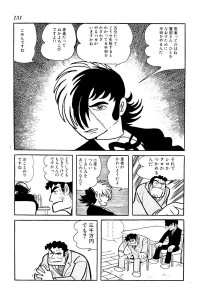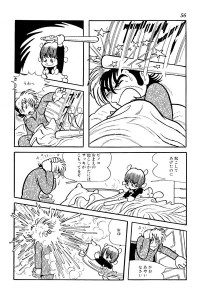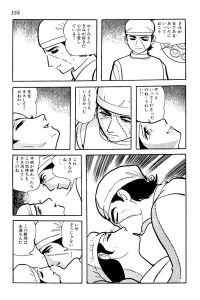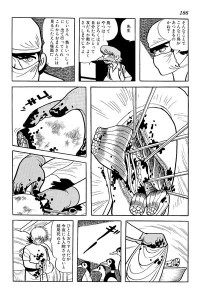Black Jack (Manga)
Also known as ブラック・ジャック (Burakku Jakku)
| English Title: | Black Jack |
| In English? | Yes |
| Japanese Title: | ブラック・ジャック Burakku Jakku |
| Type: | Chapter Serial |
| Original run: Second run: |
1973/11/19 – 1978/09/18 1979/01/22 – 1983/10/14 |
| Published in: | Weekly Shonen Champion 週刊少年チャンピオン |
| Published by: | Akita Shoten |
| Volumes: | 22 MT-151 | MT-152 | MT-153 MT-154 | MT-155 | MT-156 MT-157 | MT-158 | MT-159 MT-160 | MT-161 | MT-162 MT-163 | MT-164 | MT-165 MT-166 | MT-167 | MT-168 MT-366 | MT-367 | MT-368 MT-369 |
Black Jack (1973-83) was originally published as a serial in Weekly Shonen Champion from November, 1973 until September, 1978. This continuous run was followed by thirteen sporadic special issues, the last of which was published in October, 1983. Although it is considered one of Tezuka’s masterpieces, along with Astro Boy (1952-68), Phoenix (1967-88) and Buddha (1972-83), Black Jack (1973-83) certainly didn’t start out that way.
What it’s about
One of Tezuka’s three medical dramas, along with Ode to Kirihito (1970-71) and A Tree in the Sun (1981-86), Black Jack (1973-83) follows the adventures of Dr. Hazama Kuroo, better known by his nickname, Black Jack – an unlicensed and shadowy doctor with inhuman surgical skill.
For the most part shunned by the medical community (despite their grudging respect for his unrivaled skill as a surgeon), Black Jack operates on the fringes of society. As such, he is a popular choice for gangsters and other ne’er-do-wells with nowhere else to turn. Though he and his pint-sized assistant Pinoko try to live a quiet life in his small clinic out in in the deserted country-side, there is a steady stream of patients that other doctors have given up on beating a path to his door. He is their very last hope.
Although he is almost always able to save his patients, bringing many of them back from the very edge of death, his fees can be astronomical. Yet, his distinctive appearance, with a large scar across his face and a streak of white running through his jet black hair, and his carefully cultivated image of being heartless and corrupt, conceal a heart of gold. As kind of a “medical robin hood”, Black Jack often wields his scalpel in the name of honor and justice, righting wrongs that no one else can.
Brain transplants, fingerprint transplants, operating blind, and removing a parasitic worm from his own intestines while under assault by a pack of wild dingos are but a handful of Black Jack‘s many astonishing medical accomplishments.
What you should know
In 1973, Akita Shoten, the publisher of the popular Weekly Shonen Champion, decided to commission Tezuka for five weeks to write “anything he wanted”. According to noted Tezuka scholar, Natsu Onoda Power, in her book God of Comics: Osamu Tezuka and the Creation of Post-World War II Manga, “the editor, who felt sorry for Tezuka for his declining popularity, offered the commission as Tezuka’s ‘last work’ before retirement” (2009, p. 106). Originally conceived as a special commemorative project celebrating Tezuka’s (then) 30-year career as a manga artist, it was developed under the banner of “Osamu Tezuka’s One-Man Theater Production”, with the idea being to publish five independent stories that would spotlight Tezuka’s Star System and feature many of his characters.
However, what Tezuka came up with, was Black Jack (1973-83).
Far from the planned farewell tour, Black Jack (1973-83) was an instant success, appealing both to his die-hard fans as well as a more general audience, and it catapulted Tezuka to one of the highest levels of popularity of his career. The short 5-week commission ended up being 5 years long, from 1973 to 1978, and produced 230 chapters. What’s more, its popularity proved to be so lasting that another 13 chapters were produced intermittently over the next five years, from 1978 to 1983. It also revitalized Tezuka and spurred him on to creating other popular series such as The Three-Eyed One (1974-78).
Black Jack (1973-83), like Astro Boy (1952-68) and Rainbow Parakeet (1981-83), is an episodic manga series that can be read in any order because, with the exception of a single two-part story, each chapter is self-contained. Although the story plots can vary greatly, with Black Jack himself sometimes taking a back seat in the action, they usually focus on Black Jack being called in as the last hope and asked to perform some kind of medical miracle.
As an adventure series in the “medical thriller genre” (a genre more or less established by Black Jack), the tone of the series is usually relatively serious and somewhat dark, however it does have its lighter moments (usually involving Black Jack‘s irascible “assistant”, Pinoko). Black Jack himself is depicted as a shadowy figure, sometimes a savior, sometimes an extortionist, and even occasionally as a vicious avenger. Though he is frequently responsible for great acts of heroism, Black Jack prefers to maintain his image of being heartless and corrupt.
True to its original concept, Black Jack (1973-83) is also a haven for Tezuka’s Star System, with many of his characters making multiple different appearances, often as doctors or patients. While many of Tezuka’s regulars, such as Hamegg, Rock and Shunsaku Ban pop up, others not often seen outside their own series, such as Sapphire, from Princess Knight (1964-66), Hyakkimaru from Dororo (1967-68), Toppei from Vampires (1966-67), and even Leo from Jungle Emperor (1950-54) also make appearances.
Although Tezuka drew on his personal knowledge as a physician, and interjected a great deal of medical accuracy into the story and artwork (indeed many of the drawings are anatomically correct and could conceivably be used in a medical textbook), in general he chose to eschew medical plausibility in favour of a good story. As such, Black Jack‘s medical feats are truly superhuman, such as operating while totally blind, completely from memory, or transplanting an entire nervous system. One of these miraculous operations resulted in his comedic sidekick, Pinoko. Despite originally being a rare type of parasitic twin, basically a formless jumble of organs, Black Jack is able to surgically extract her organs and then place them in a body specially constructed as a plastic exoskeleton – resulting in a pint-sized fireball daughter figure for the emotionally distant doctor.
In many ways Black Jack is the medical doctor Tezuka wished he could have become – operating outside the constraints of the Japanese medical establishment. As such, many of the themes explored in Black Jack contain Tezuka’s social commentary in regards to the deficiencies he perceived in Japanese medicine, including such things as the level or corruption, doctors cultivating hero-worship, and a general adherence to hierarchy at all costs. However, given the level of Tezuka’s fame as well as his recaptured popularity, Black Jack (1973-83) became increasingly vulnerable to criticism from various sources, the harshest being the medical community. He later confessed that, in an effort to manage complaints and criticisms, he began to avoid naming specific medical conditions – effectively making Black Jack more of a simple E.R. surgeon. This is one of the main reasons he decided to end the regular serialization of Black Jack (1973-83) in 1978 after 230 chapters. However, Tezuka was never one to give up on a good thing, and the regular serialization was followed by thirteen sporadic special issues, the last of which was published in October, 1983.
Tezuka himself was sensitive to even the slightest complaints regarding certain conditions/diseases – especially from patients or their families. As such, if he felt he had offended his fans, he often changed dialogue in, or even excluded certain chapters from, future collections of Black Jack (1973-83). These excluded chapters were usually left out for controversial or political reasons, but in some cases simply because Tezuka wasn’t satisfied with a story he’d felt he rushed on, or thought was incomplete. While many of the excluded chapters have been printed in at least one Japanese collected edition, there are five ‘sealed’ or ‘semi-sealed’ chapters that have almost never been reprinted since they originally appeared in Weekly Shonen Champion.
Where you can get it
For English-speaking fans, there have been two Black Jack (1973-83) translated editions. The first English language edition, containing a selection of chapters, was released by VIZ. The chapters were originally serialized in Animerica Extra, and then collected in 1999 in two paperback editions: Black Jack, and Black Jack 2 – Two-Fisted Surgeon. Nowhere near complete, this edition is long out of print.
Black Jack (1973-83) was again released between 2008-11 by Vertical, Inc.. This seventeen volume edition is based on the hardcover Akita Deluxe Edition – the collection Tezuka himself arranged and edited. This “nearly complete” set is only missing the sealed, semi-sealed and some of the excluded chapters.
It is interesting to note, the first three volumes were also released as special “exclusive” hardcovers with different cover artwork and design. Each exclusive volume contains one special chapter not included in the standard Akita release. These are three of the excluded chapters that Tezuka himself removed from the collection, however Vertical, Inc. received special permission from Tezuka Productions to include them.
Special note: The third exclusive hardcover volume also contains an essay by Tezuka in English‘s own Ada Palmer, titled Black Jack: the Excluded Issues, and Osamu Tezuka’s ‘Star System’.
What else you should check out
Check out the links below for chapter summaries and more detailed publication information on Black Jack (1979) serialization in Weekly Shonen Champion.

